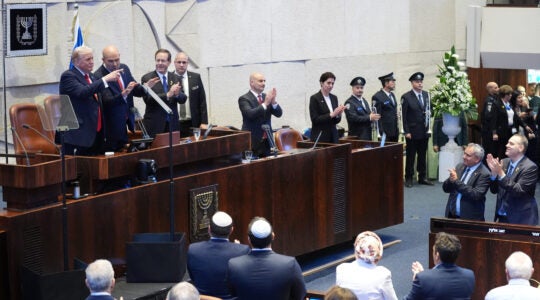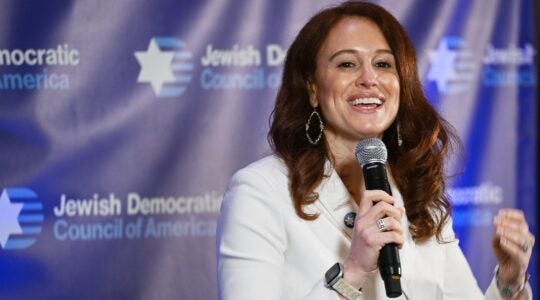JERUSALEM (JTA) — Jared Baluvan is from Highland Park, N.J. Jared Blumenfeld is from Beverly Hills. Both are 18 and in Israel volunteering on an ambulance as part of Young Judaea’s Year Course in Israel. But while the $15,000 tuition for the program was no problem for Blumenfeld’s family, Baluvan’s needed some help. Assisting families like the Baluvans was why the Jewish Agency for Israel and the Israeli government started MASA, which offers grants of up to $10,000 to Diaspora Jews aged 18 to 30 to participate in long-terms programs in Israel. The program has helped bring some 7,800 participants to Israel this year from 50 countries. They participate in programs ranging from Orthodox yeshivas to training seminars for secular Zionist youth movements. The idea, MASA officials say, is that extended time in Israel and immersion in Israeli society is the best way to build Jewish identity and form a connection to the Jewish state.MASA wants to use the experience to create future Jewish leaders and show that Israel is no longer a state that just takes money from the Diaspora, but is an equal partner in building broader Jewish community. “This is about closing the gap” between Israel and the Diaspora, Jewish Agency Chairman Ze’ev Bielski said in a meeting with reporters Monday in Jerusalem. MASA eventually would like to bring 20,000 young Jews to Israel each year. Both the government and Jewish Agency, which provide equal parts of the funding, have committed to spend up to $50 million a year on MASA. Assistance from MASA has opened up programs like Livnot U’Lehibanot — which combines volunteerism, learning and hiking — to more people like Ben Pitt. Pitt, 23, felt he needed time to figure out what he wanted to pursue after graduating from Brown University. He had been to Israel several times with his family and had gone on a birthright israel trip, but wanted to return after school to do something more productive. The Providence, R.I., native said the Old City of Safed, where he lives with 18 other Livnot volunteers, was just the place. He’s finding perspective in a town famous for Jewish mysticism, where a typical conversation “starts with talking about the weather, and in 10 minutes you’re talking about why we’re here.” By day Pitt and the other Safed-based volunteers work in local schools teaching English to elementary school students. In their free time they explore the country. MASA started in 2004 with 45 participating programs; since then another 120 have joined. In an effort to ensure diversity, it wants more programs that promote pluralism and build the non-Orthodox religious movements in Israel, and that focus on helping weaker, impoverished segments of society. Programs must meet a series of requirements, which include an emphasis on teaching Hebrew, and strengthening Jewish identity and Zionism, as well as involvement and volunteerism in Israeli society. Each program receives a stipend. Long-term study in Israel traditionally has been dominated by the Orthodox — a pre-college year or two in an Israeli yeshiva is typical for graduates of American yeshiva high school students. But MASA money has spurred the formation of some 40 new programs that draw from a vastly different pool of Jews, MASA spokesman Lior Shmueli said. The Rimon School for Jazz and Contemporary Music in Tel Aviv and the Bezalel Academy for Art and Design in Jerusalem both have started programs for overseas students. The Reform movement in Israel has developed or upgraded five programs. Such opportunities have drastically shifted the ratio of Orthodox to non-Orthodox students from overseas who spend a year in Israel after high school. Before 2004 it was estimated that approximately 2,000 Orthodox students studied in Israeli yeshivas, while there were about 2,000 non-Orthodox students in universities and gap-year programs. This year there are about 3,000 Orthodox students and 5,000 non-Orthodox students in long-term programs, Shmueli said.The number of Orthodox students receiving MASA money could continue to fall as MASA officials take a harder look at participating yeshivas to make sure they comply with the organization’s Zionist and participatory requirements. MASA also could help fill social needs in Israel. As the economy increasingly is privatized and the government cuts welfare benefits, MASA participants will provide more than 200,000 days of community service in 400 fields this year. MASA also could provide an economic boon to communities where participants spend a year. Programs often need to rent apartments for their participants, sometimes in the lower-income neighborhoods they serve. In addition to the rent, there are taxes and water and electricity bills that are paid to local municipalities. It’s a big help, said Avi Noam Grenot, an Education Ministry official in Holon, which houses a Young Judaea group. Young Judaea, the youth movement of Hadassah, suggests that participants bring a minimum of $4,000 in spending money, and participants, especially the Americans, often come flush with cash, which they spend in local restaurants and markets. While many participants say they are considering aliyah, that’s not MASA’s goal. MASA officials say they want participants to become leaders in their home Jewish communities as activists and later as philanthropists. Since MASA’s inception there has been debate about partnering with birthright israel, which since 1998 has sent more than 100,000 young Jews to Israel on free 10-day tours. MASA officials would like their program to be the official follow-up to birthright, but birthright officials have hedged on the issue. The two groups appear to be moving toward some collaboration. Cabinet Secretary Israel Maimon, the Israeli government’s liaison to MASA, told reporters Monday in Jerusalem that he met last week with birthright CEO Shimshon Shoshani to discuss the issue.Officials from the two programs are to meet again within 10 days to discuss a possible collaboration between the marketing departments, Maimon said. MASA’s funding also will change next year, which has some program directors anxious. Instead of granting up to $10,000 per participant based solely on need, MASA will provide $2,000 to every American undergraduate student and $4,500 to every American graduate student. The program will retain need-based scholarships of up to $10,000 for participants from the former Soviet Union and some other areas, and will have a $2.5 million fund for additional need-based scholarships to Americans, MASA CEO Elan Ezrahi said. But he added that individual programs will need to do some of their own fund raising to fill in gaps. “This is an exciting time,” Ezrahi said. “As Jews become more interested in social service, now they can come here to Israel and do it in a pluralistic but nationalistic way.”MASA, he said, “is the merger of two worlds.” (JTA Staff Writer Jacob Berkman was a guest of the Jewish Agency for Israel on a trip to Israel and Ukraine.)
JTA has documented Jewish history in real-time for over a century. Keep our journalism strong by joining us in supporting independent, award-winning reporting.





